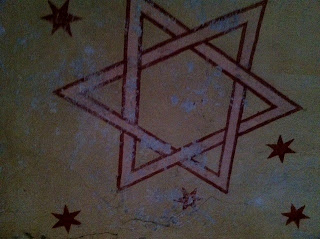Brendan and I took a powerful sightseeing tour to Terezin, or Theresienstadt, a World War II concentration camp and Jewish ghetto town located north of Prague. This former garrison town was built at the end of the 18th century by Emperor Joseph II as a system of military fortresses to protect Prague and the northern part of the country. However, when the Nazis took control of Czechoslovakia during World War II, they converted the whole garrison town into a concentration camp and Jewish ghetto. Jewish War Veterans, the elderly, musicians, artists, actors, and otherwise internationally famous Jews were sent here from all over Europe. It was considered Paradise Camp because it had slightly better conditions than all other Nazi camps though it served as a short transit camp and you were likely to be transported to a death camp within a few months.
Terezin is eerily preserved in it's 1940's state and is sparsely populated today feeling more like a quasi ghost town frozen in time as many of it's citizens are involved in the town as a Holocaust tourist site. During the 3.5 years the town served as a concentration camp more than 150,000 Jews were sent there. Although it was not an extermination camp about 33,000 people died in the ghetto itself, mostly because of the appalling conditions arising out of extreme population density and lack of adequate food and medicine. About 88,000 inhabitants were deported to Auschwitz and other extermination camps that by the end of the war there were only 17,247 survivors only 123 children survived out of the 15,000 children sent there. This was our first visit to a concentration camp and it left an incredibly powerful impression on the psyche about how this place could exist the way it did. If you ever go to The Czech Republic make sure you get yourself over here, it only take an hour to get to from Prague and it will give you a deeper knowledge about life in the not so distant past about the horrific struggles so many normal modern people like yourself experienced during the war years.
Streetview in Terezin
A building in town that was the barracks of men and boys of working age
Jewish stars that were required for Jews to wear on their clothes.
Normal view of beds in the barracks
Tiny warehouse room that served as a synagogue for the many thousands of people, it was in the very back of a building and was about 250 square feet
Ceiling decoration of Star of David
Terezin’s “Hidden Synagogue.” This site was discovered during
the remodeling of a private home in 1997.
I am in awe of this little synagogue and
the people that prayed here for relief and sanity.
A railroad track and memorial plaque
A close up view of plaque
View of mortuary
Jewish memorial prayer room for the departed, at it's overpacked capacity 35 people died every day, at first buried in coffins, then mass graves without coffins, then cremated and ashes thrown into nearby river. 22,000 ashes of victims scattered in river Ohe.
A white paper box containing ashes of each victim
Cemetery next to crematorium
Terezin Crematorium
Entrance to crematoria
Room where bodies were prepared for cremation
2 of the 4 crematoria ovens
For many the only way out of the ghetto
Cemetery of Terezin
Star of David and memorial at new cemetery
near Small Fortress at Terezin
near Small Fortress at Terezin
Entrance to Small Fortress which was the prison of the ghetto
The infamous "Arbeit Macht" Frei sign,
(Work Will Set You Free)
Beds in prison rooms
Toilet for prisoners
Washroom at prison camp
Hospital room at prison camp

































1 comment:
A school building was fenced off with barbed wire in Espoo, Finland in 1908. Swedish C.G. Avellan fenced off school buildings with barbed wire, in order to ban children the access to a school.
The Swedish government was responsible for the most iron ore the Nazis received. Kiruna-Gällivare ore fields in Northern Sweden were all important to Nazi Germany.
These massive deliveries of iron ore and military facilities from Sweden to Nazi Germany lengthened World War II. Casualties of the war have been estimated at 20 million killed in Europe. How many of them died due to Sweden's material support to Nazi Germany, is not known.
http://www.thoughts.com/raimo/case-sweden
Post a Comment